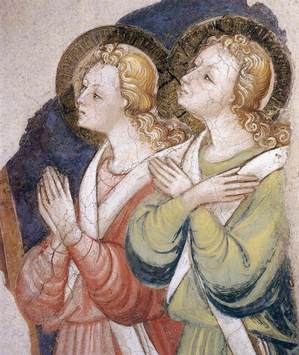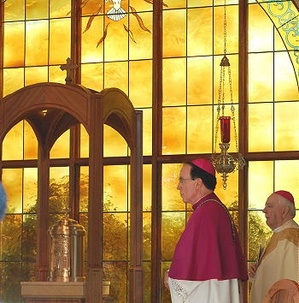Let’s remember Abbot Hugh Anderson, abbot-president and the Benedictine monks of the American Cassinese Congregation who observe today as a patronal feast of their congregation.
Category: Sacred Liturgy & Sacraments
Exaltation of the Holy Cross
Let us lift up our voices high;
Holy Apostles Seminary Chapel dedicated
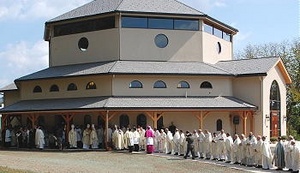 Zacchaeus, make haste, and come down; for today I must abide at thy house. And he made haste, and came down, and received him joyfully into his house. This day is salvation come to this house from the Lord, alleluia.
Zacchaeus, make haste, and come down; for today I must abide at thy house. And he made haste, and came down, and received him joyfully into his house. This day is salvation come to this house from the Lord, alleluia.
Reclaiming a deeper sensitivity to the sacred Liturgy
Today, the Director of the Liturgical Institute at Mundelein Seminary, Father Douglas Martis, gave the following address today. Father Martis is a priest of the Diocese of Joliet and on the faculty of Mundelein Seminary. Some very useful lessons to keep in mind.
I. Sons.
My Dear Sons,
This was the term used by Fr. Fuller on Monday morning, “sons.” It is a beautiful expression. You are sons to us. Our relationship, despite the distance or proximity of age, is one of father and son, or in certain cases, as with our Director of Music, one of motherly concern. No disrespect to your age or your experience is intended.
We have a common project here, to prepare you for ministry to the Church as priests.
And for those of us concerned directly with your liturgical formation, our project is to prepare you in such a way as to manifest an authentic and profound intelligence of and respect for the Church’s public prayer, so as to demonstrate a true love for God’s people.
This responsibility belongs jointly to you and to us. While it is true that in some ways you are brothers, on another day you will be brothers in a deeper sense. For now, you sons, we love you, and care for you, and want genuinely go give to you what parents give to beloved sons.
What we do, that to which we have committed these years of our lives, is for your good for the good of the Church.
My colleagues and I have strong personalities. We do not have an innate need to challenge you or correct you in order to caress on own self-importance. The program we have of liturgical preparation and celebration, of respecting ritual and integrating prayer, of insisting on music and chant is not the imposition of our own puny personal preferences.
Our teaching is derived from the desire of the Church herself: rooted inSacrosanctum concilium, the ritual books that are the fruit of the Council, and the Church’s liturgical theology.
It is neither our interest nor our agenda to promote our opinions as if they carried the authority of the Church. Our desire is to present you with the Church’s teaching, for love of you and love of her.
We want you to follow our example.
II. Change.
Things change. That’s okay.
Get used to it. New classmates, new teachers, new schedules. New prayers, new responsibilities, new living situations. New circumstances, new trends, new conflicts. New joys, new insights, new challenges.
This is the life of a priest in the 21st century.
Learning to navigate change is an essential skill you will need for the rest of your lives.
Let us be clear. God remains the same. Our upset, generally has more to do with what we want,than with the objective reality of the change. This is not about you.
The church of the 1960s saw excitement and enthusiasm, and resistance, too.
In your situation today, learn to appreciate your elders’ excitement, enthusiasm, and resistance. In 2011 you will know the same. Excitement, enthusiasm, and resistance.
Change leads some to heresy or schism.
Avoid the temptation of being captured by the caricatures of the media, whether your news source is FOX or CNN, whether you are a fan of NCReporter or NCRegister whether you get your information from the blogs or from television. Do not allow yourself to get sucked in by the politics of resistance. When change leads to dissemblance, only the devil is served.
As priests, ministers, official representatives of the Church, you have a greater responsibility than settling for, or promoting polemics. Not only that, as a man of prayer, you have–even now!–the responsibility of learning to embrace the beauty, the rich theology, the deep spirituality of the Church’s liturgical prayer.
You can stand aloof as a member of an elite that knows the rich treasure of prayer or having integrated it yourself you can teach, inform, model, and so help others to do the same.
What is needed here is not a so called “pastoral decision” of diluting prayer but a conviction of genuine care, catechesis and formation that raises up the faithful.
This may be the greatest ecclesial moment in your lifetime. Yours is not the only generation to have ever known liturgical change.
“We are not in the same situation as … 1963. One cannot therefore continue to speak of a change as it was spoken of at the time of the Constitution’spublication; rather one has to speak of an ever deeper grasp of the Liturgy of the Church, celebrated according to the current books and lived above all as a reality in the spiritual order.”[i]
…now
the time has come … to publish liturgical books in a form that both testifies to the stability achieved and is worthy of the mysteries celebrated.[ii]”
If the intuition of Pope John Paul II is correct, if the Third Edition of the Roman Missal signals the maturity of liturgical reform, its dignity and stability, then the post-Counciliar church has survived adolescence and provides the opportunity now for a more adult expression of faith. You and I stand on the threshold of this moment!
III. Texts.
The challenge with public prayer has always been to make the words our own. Let us understand then, that the great opportunity afforded us in this moment is not one of changing words. This is about opening a more direct path to the meaning of Catholic worship–a meaning that has always been there and is there even now in the texts we use today.
What, then, are we to do?
Here is the simple prescription:
Take the words,
learn to understand them,
make the connections.
Follow the example of ancient readers:
take the text, do not read it through as if you already understand [this “mystery ever ancient, ever new!”] take the text, dwell there. Abide between the lines.[iii]
“This quality of reading, which enables a reader to acquire a text not simply by perusing the words but by actually making them part of the reader’s self…”[iv] Here is found true blessing.
Know what you are doing. Listen for the biblical narrative. The texts of the Mass were not put there by some malicious committee looking to trip you up. These texts resound with the voice of God’s own Word. Find the origin, search the reference.
I know this is not easy. We live in a culture that does not foster this kind of connection. Contemporary culture thrives on sound bites; idolizes short cuts and Cliffnotes, Sparknotes and books for dummies.
For your part, claim your place in Catholic culture, with its own language and grammar, its own symbols and meaning.
Plunge yourself in a baptism of the Church’s signs. Let the insight of your patristic reading anoint your understanding and illumine your prayer. Open your eyes to what is around, even here on this campus, with its natural beauty, its architectural wonders, its volumes of wisdom, and its varied residents.
A steady diet of this, an habitual practice of attention to everything is an essential preparation for prayer. Collect these insights, engage these people, absorb this environment.
Your responsibility as seminarian, is to learn this, to integrate it; then you must model it for others and teach it to those in your care.
You become a mystagogue.
IV. Now.
This begins now. You do not have to wait. You walk out of this auditorium and cross a threshold.
Let that crossing be the crossing of every threshold.
Let every word of the Mass bring you to a biblical narrative, a theological insight, a pastoral encounter.
Let every sign of the Cross bring you to the mount of the Ascension.[v] Let it be, every time, a wrapping yourself in the Trinity, a conforming yourself to the cross of Christ. May it bring you back to your baptism and forward to your funeral. May it inspire the crosses you may trace some day on the breast of future neophytes, on the foreheads of the anointed, on the palms of priests.
Let every greeting of the Mass resound with the words of the great missionary Paul,[vi] or the salutation of Boaz to harvesters,[vii] or the words of the Risen Christ.[viii]
Let every response, whether it be “And also with you” now or “And with your spirit” at another time, let this reply make us marvel at God’s wisdom in Ordering the Church and in the Spirit’s work of assembling members with different gifts into one holy body.
Let every procession remind us of life’s pilgrimage to heaven; every standing be in implicit imitation of the Great High Priest: “Here I am, Lord. I come to do your will.”[ix] Let every genuflection, every bow be the humble acknowledgement of what God has done for us in Christ Jesus.
Let our stance at the Alleluia be so completely devoted to the praise of Christ present in the Word, that rather than tracking the deacon and registering ritual glitches, our minds, bodies and voices melt into the Eternal.
Let prayers in the preparation of bread and wine, bring us to Daniel’s fiery furnace, so that the words of Azariah become our own: we have nothing else to offer, but with contrite hearts and humble spirits let us be received.[x] And may the dew-laden breeze[xi] that soothed the heat of that inferno, come like dew in the desert,[xii] to provide us with our daily bread.”Priests of the Lord, bless the Lord.” [xiii]
Let every dismissal, GO! bring us back again to Ascension,[xiv] and to every sending of
Christ: “You, too, go to the vineyard!”[xv]
Do you see? At every moment, at every turn, around every corner, the bible is there. A prayer, a doctrine, an insight. And it has been there all along.
All we have, are, do, everything we love… is here.
Learning this. Integrating this. Modeling this. Teaching it is our project.
Will you make it your project too?
Notes
[i] Vicesimus quintus annus, 1988, 14.
[ii] VQA, 20.
[iii] Alberto Manguel: A History of Reading. “You did not read books through; you dwelt, abided between their lines and, reopening them after an interval, surprised yourself at the spot where you had halted.”, 12.
[iv] Manguel, 58.
[v] Mt 28:19.
[vi] 2 Cor 13:13 et al.
[vii] Ruth 2:4.
[viii] Jn 20:19.
[ix] Heb 10:9.
[x] Dan 3:39-40.
[xi] Dan 3:50.
[xii] Ex 16:13-17.
[xiii] Dan 3:84.
[xiv] Mt 28:19.
[xv] Mt 20.D
Liturgical New Year for the Byzantine Church
Happy New Liturgical Year for the Byzantine Church! Have a blessed 7519!!! The Byzantine Church understands this date to be the years since the creation of the world. A new liturgical year, a new beginning to give God glory, honor and praise!!!!
Britain’s Bishops have no taste
 The UK Bishops’ Conference will be providing the Holy Father –and the Church universal– this sanctuary for the Sacrifice of the Mass and the Rite of Beatification for Cardinal Newman. The the only possible thing to say is: OMG!!!! What rubbish.
The UK Bishops’ Conference will be providing the Holy Father –and the Church universal– this sanctuary for the Sacrifice of the Mass and the Rite of Beatification for Cardinal Newman. The the only possible thing to say is: OMG!!!! What rubbish.
Blessing of Grapes
 A pious liturgical custom is for the priest to bless grapes on the feast of the Transfiguration of the Lord. Why do we bless grapes on the Transfiguration? Symbolically and on a concrete level grapes represent real transformation, an old vine produces new fruit, a new harvest for God. As the Lord was transfigured on Mount Tabor, so we too are given the grace by God to transform our lives more and more according to His will, the Gospel. The hard of personal conversion is done by authentically following the Church.
A pious liturgical custom is for the priest to bless grapes on the feast of the Transfiguration of the Lord. Why do we bless grapes on the Transfiguration? Symbolically and on a concrete level grapes represent real transformation, an old vine produces new fruit, a new harvest for God. As the Lord was transfigured on Mount Tabor, so we too are given the grace by God to transform our lives more and more according to His will, the Gospel. The hard of personal conversion is done by authentically following the Church.
Theologically, one might say that the grape is symbolic of new life; think of the fruit derived from grapes, wine, used at Mass. That after the overshadowing of the Holy Spirit and the prayer of consecration the wine becomes the Precious Blood of Christ. It is by His Blood we are saved, given new life, a pledge of future glory with the Blessed Trinity in heaven. Many liturgical families, including the Latin, Byzantine and Armenian Churches have a liturgical theology and rite for the blessing of grapes and situate the blessing of grapes as a needed reminder of our real and on-going conversion to Christ in hearts and minds of Catholics. (Read this blog post on the blessing of grapes where the author brings together several elements: work, harvest, offering, human transformation by God, liturgy, new life, etc.).
The prayer
Priest: Our help is in the name of the Lord.
Response: Who made heaven and earth.
Priest: Let us pray to the Lord.
Response: Lord, have mercy.
Bless, O Father, this new fruit of the vine, which you permitted to ripen through good weather, and drops of dew and may it bring joy for us who will partake of this fruit of the vine, and forgiveness of sins to those who offer it, through the pure Body and Blood of Your Christ, with whom You are blessed, together with Your all holy, good and life-giving Spirit, now and always and forever and ever.
R. Amen.
(this blessing is taken from the August Menaion, Byzantine Melkite Euchologion published by the Melkite Eparchy of Newton.)
Transfiguration of the Lord
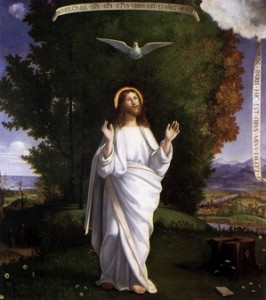 The Master came with his three friends
The Master came with his three friends
To climb Mount Tabor’s height
There he was changed,
transfigured with God’s uncreated light.
As Daniel, seer of old, had seen
One like a Son of Man,
On whom were kingship, sov’reignty,
And place at God’s right hand,
So too, said Peter, we have seen
His glory, come from God,
Revealed to us, who with him lived
And walked in ways he trod.
“This is my Son,” the Father said,
“In him is my delight.
To him give ear, that all your ways
May be within my light.”
Bring us, O Lord, to hear your Son
That, walking in his ways,
We as your daughters and your sons
May praise you all our days.
J. Michael Thompson
Copyright © 2009, World Library Publications
CM; ST. MAGNUS, ST. STEPHEN, MORNING SONG
Dedication of the Basilica of Saint Mary Major
 A few times a year the Church’s sacred Liturgy observes a liturgical memorial of a church’s dedication and today is one of those observances. When you get down to brass tax we don’t glorify a building but the action of the Blessed Trinity in the lives of believers.
A few times a year the Church’s sacred Liturgy observes a liturgical memorial of a church’s dedication and today is one of those observances. When you get down to brass tax we don’t glorify a building but the action of the Blessed Trinity in the lives of believers.
The truth of the Liturgy opens the door to salvation
The liturgical wars of the past years are not over, they’re not even close to coming to an end. Too many people have a stake in what will happen with the promulgation of the new Roman Missal in English and then the forthcoming translations of the Divine Office, and sacraments. I look forward to the day when the newly approved psalms get inserted in the daily use of the Church’s rites, especially in monasteries where being in conformity with the mind of the Church is not always a value. Ultimately we have to say that the various “insights”, agendas, ways of doing things and thinking are in conflict with the whole of the Church’s Tradition of continuity. While it is quite fine to be novel in the place where you live and perhaps in the market and work place, no doubt these places rely on new ways of doing things to “spice up life,” novelty has no place in liturgical theology, liturgical texts, rubrics, gestures and homilies. What is often missing in the work of liturgical theology and the praxis of the “faith community” is Christ, the true seeking of God’s face under the power of the Holy Spirit. How is it that we can claim to be one Church, one faith, working out salvation as proposed be Christ and the Church?
For me, Father Roman Guardini sets the stage of what the truth of the sacred Liturgy is and what its virtue is for the believer.
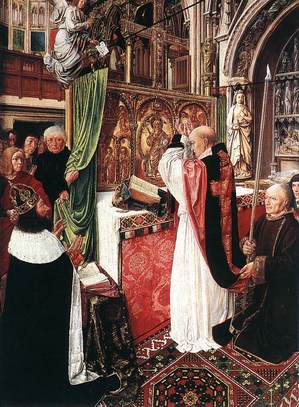 The Church has not built up the Opus Dei for the pleasure of forming beautiful symbols, choice language, and graceful, stately gestures, but she has done it — in so far as it is not completely devoted to the worship of God — for the sake of our desperate spiritual need. It is to give expression to the events of the Christian’s inner life: the assimilation, through the Holy Ghost, of the life of the creature to the life of God in Christ; the actual and genuine rebirth of the creature into a new existence; the development and nourishment of this life; its stretching forth from God in the Blessed Sacrament and the means of grace, towards God in prayer and sacrifice; and all this in the continual mystic renewal of Christ’s life in the course of the ecclesiastical year. The fulfillment of all these processes by the set forms of language, gesture, and instruments, their revelation, teaching, accomplishment and acceptance by the faithful, together constitute the liturgy. We see, then, that it is primarily concerned with reality, with the approach of a real creature to a real God, and with the profoundly real and serious matter of redemption. There is here no question of creating beauty, but of finding salvation for sin-stricken humanity. Here truth is at stake, and the fate of the soul, and real — yes, ultimately the only real — life. All this it is which must be revealed, expressed, sought after, found and imparted by every possible means and method; and when this is accomplished, lo! it is turned into beauty.
The Church has not built up the Opus Dei for the pleasure of forming beautiful symbols, choice language, and graceful, stately gestures, but she has done it — in so far as it is not completely devoted to the worship of God — for the sake of our desperate spiritual need. It is to give expression to the events of the Christian’s inner life: the assimilation, through the Holy Ghost, of the life of the creature to the life of God in Christ; the actual and genuine rebirth of the creature into a new existence; the development and nourishment of this life; its stretching forth from God in the Blessed Sacrament and the means of grace, towards God in prayer and sacrifice; and all this in the continual mystic renewal of Christ’s life in the course of the ecclesiastical year. The fulfillment of all these processes by the set forms of language, gesture, and instruments, their revelation, teaching, accomplishment and acceptance by the faithful, together constitute the liturgy. We see, then, that it is primarily concerned with reality, with the approach of a real creature to a real God, and with the profoundly real and serious matter of redemption. There is here no question of creating beauty, but of finding salvation for sin-stricken humanity. Here truth is at stake, and the fate of the soul, and real — yes, ultimately the only real — life. All this it is which must be revealed, expressed, sought after, found and imparted by every possible means and method; and when this is accomplished, lo! it is turned into beauty.
This is not a matter for amazement, since the principle here at work is the principle of truth and of mastery over form. The interior element has been expressed clearly and truthfully, the whole superabundance of life has found its utterance, and the fathomless profundities have been plainly mapped out. It is only to be expected that a gleam of the utmost splendor should shine forth at such a manifestation of truth.
For us, however, the liturgy must chiefly be regarded from the standpoint of salvation. We should steadfastly endeavor to convince ourselves of its truth and its importance in our lives. When we recite the prayers and psalms of the liturgy, we are to praise God, nothing more. When we assist at Holy Mass, we must know that we are close to the fount of all grace. When we are present at an ordination, the significance of the proceedings must lie for us in the fact that the grace of God has taken possession of a fragment of human life. We are not concerned here with the question of powerfully symbolic gestures, as if we were in a spiritual theater, but we have to see that our real souls should approach a little nearer to the real God, for the sake of all our most personal, profoundly serious affairs.
For it is only thus that perception of liturgical beauty will be vouchsafed to us. It is only when we participate in liturgical action with the earnestness begotten of deep personal interest that we become aware why, and in what perfection, this vital essence is revealed. It is only when we premise the truth of the liturgy that our eyes are opened to its beauty.
The degree of perception varies, according to our aesthetic sensitiveness. Perhaps it will merely be a pleasant feeling of which we are not even particularly conscious, of the profound appropriateness of both language and actions for the expression of spiritual realities, a sensation of quiet spontaneity, a consciousness that everything is right and exactly as it should be. Then perhaps an offertory suddenly flashes in upon us, so that it gleams before us like a jewel. Or bit by bit the whole sweep of the Mass is revealed, just as from out the vanishing mist the peaks and summits and slopes of a mountain chain stand out in relief, shining and clear, so that we imagine we are looking at them for the first time. Or it may be that in the midst of prayer the soul will be pervaded by that gentle, blithe gladness which rises into sheer rapture. Or else the book will sink from our hands, while, penetrated with awe, we taste the meaning of utter and blissful tranquility, conscious that the final and eternal verities which satisfy all longing have here found their perfect expression. But these moments are fleeting, and we must be content to accept them as they come or are sent. On the whole, however, and as far as everyday life is concerned, this precept holds good, “Seek first the kingdom of God and His justice, and all else shall be added to you” — all else, even the glorious experience of beauty.
Father Romano Guardini, The Spirit of the Liturgy (New York: Crossroad Publishing, 1998, p 83ff, reprint of 1930 Sheed & Ward edition, trans., Ada Lane).
